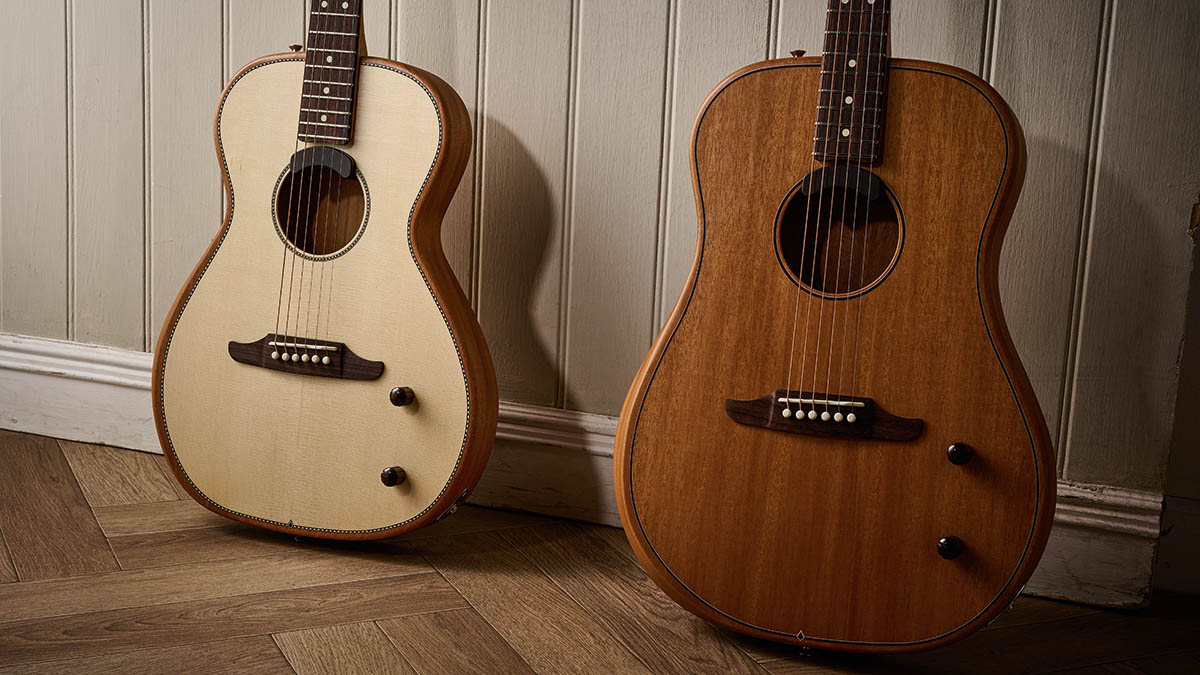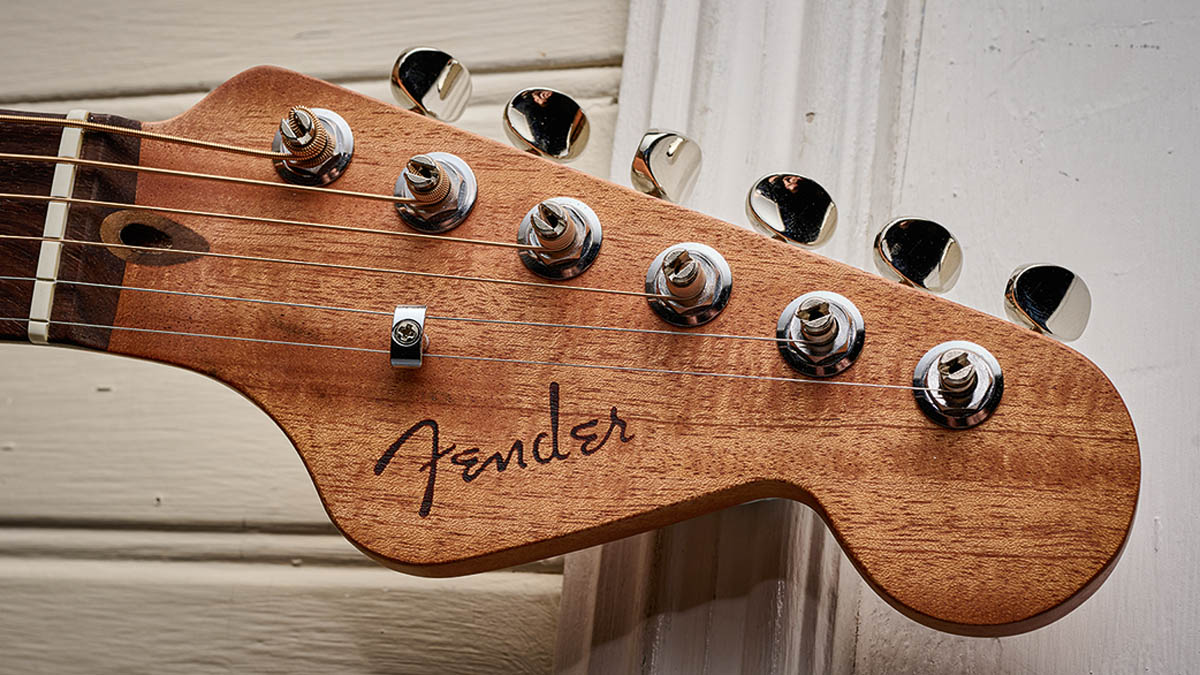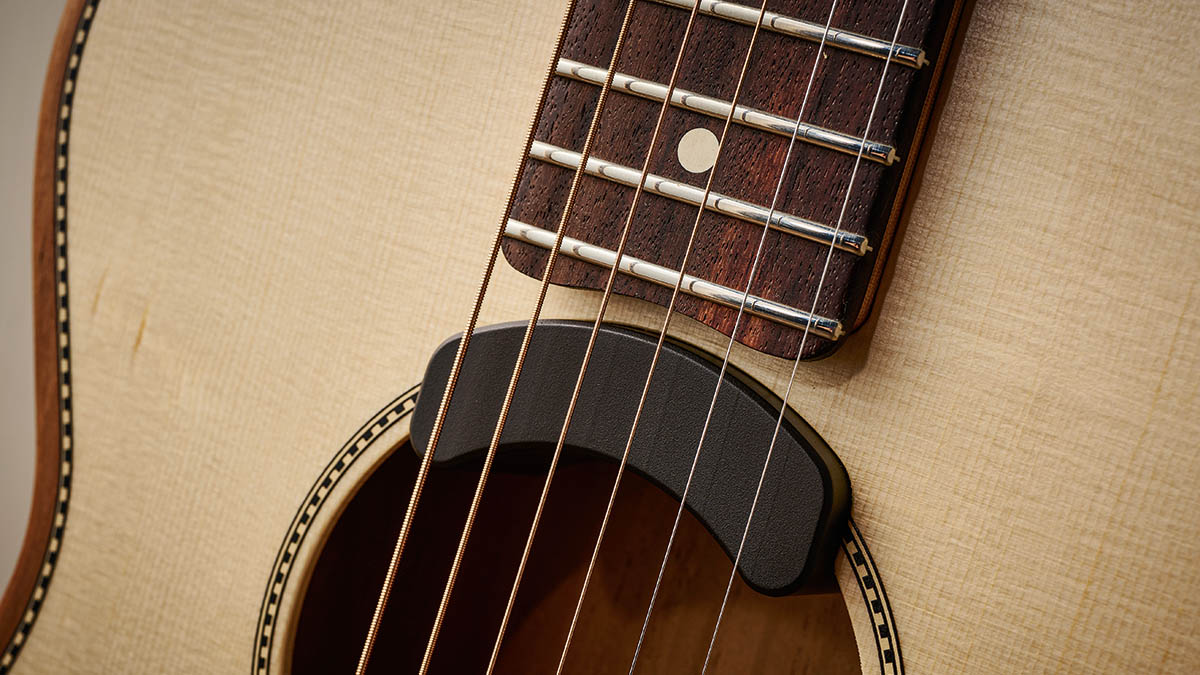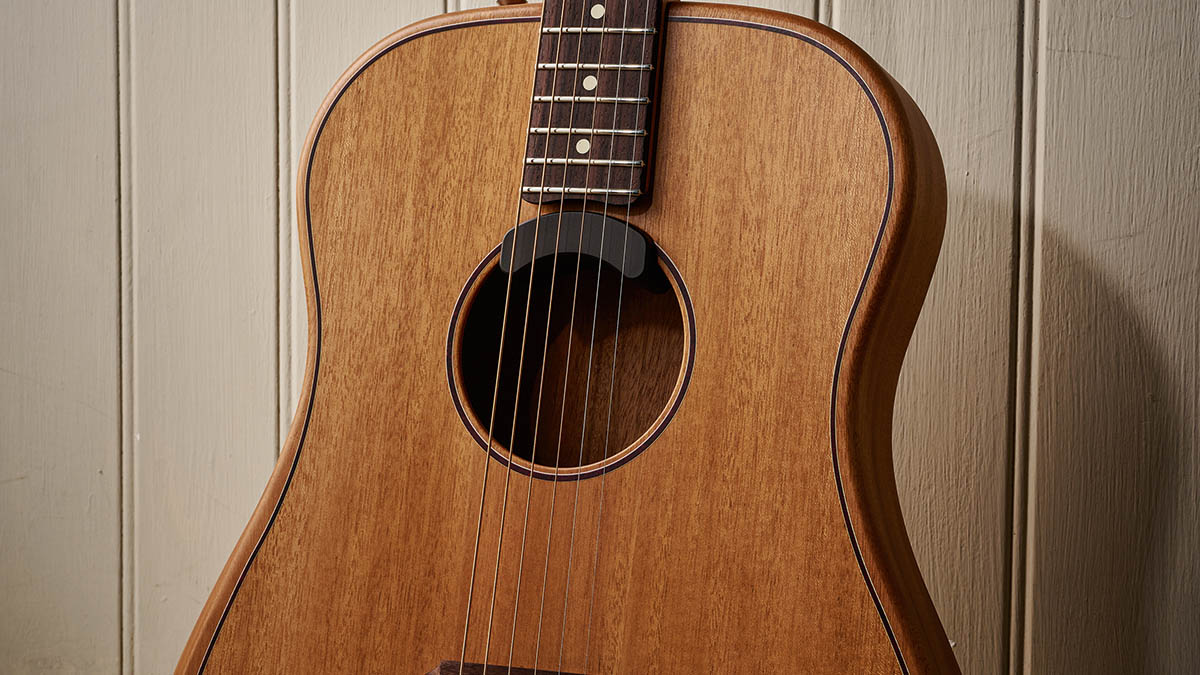
When Fender’s American Acoustasonic Telecaster debuted at Winter NAMM in January 2019, it raised eyebrows with its eye-catching style and unique construction. Yet its immediate success surprised even Fender.
The first year’s production sold out from orders at that very first show and more models soon followed. It seems plenty of players wanted live acoustic (and electric) tones, but couldn’t live with the faff that goes with using a full-size flat-top on stage. They probably fancied something a bit sexier-looking, too.
With an eye on another potentially huge market, Fender reasoned that there was another raft of players who would prefer something that – from the audience’s viewpoint, at least – could pass for a regular acoustic.
Enter the Highway Series, the first two models of which are the Ensenada-built Dreadnought and Parlor, each available with either mahogany or Sitka spruce tops. And while the bodies of both instruments are a mere 57.15mm (2.25 inches) deep, they are fully chambered, with what Fender calls ‘tapered floating X bracing’.
While the guitars’ construction is ultra‑modern and radical, their materials couldn’t be more traditional. So we find fully hollow bodies with sides and backs of mahogany, and necks made of the same material.

What makes each guitar look different (apart from its size) is this choice of either a spruce or mahogany top, and slightly different edge and soundhole purfling for each top type. Fingerboards are East Indian rosewood, the bodies are finished in a thin-skin satin polyester, and the three-bolt necks are coated with an open-pore satin urethane.
The minimalist appearance, with only simple cosmetic appointments – ‘chequerboard’ edge purfling and soundhole ring on the spruce versions, and dark and light stripes on the mahogany – echoes the simple aesthetic of Fender’s electrics but with a big nod towards old-fashioned acoustic guitar design. And that six-a-side peghead? Bring it on! It goes so well with these guitars’ looks, and the etched-in spaghetti logo screams vintage Fender, too. What’s not to love?
Although cosmetic details are pretty similar on the differently timbered models, dimensionally their bodies are very different, the Dreadnought being 380mm (14.96 inches) across its lower bout and the Parlor significantly more diminutive at 370mm (14.57 inches) respectively.

Other details include a 305mm (12-inch) radius 20-fret fingerboard with a 629mm (24.75-inch) scale length; a Tusq nut and a nut width of 42.86mm; recessed headstock truss adjustment with walnut skunk stripe; six-a-side vintage-style tuners; three-bolt neck join with Micro-Tilt and a ‘modern Viking’ rosewood bridge sporting white pins. Also, a quick-release battery compartment sits within a black plate on the rear of each model.
A word about construction. The Highway models’ backs, sides and heel block are actually hewn from a single piece of mahogany, with the separate top dropped in. This gives the guitars their light but chunky feel, and makes creating the comfy forearm and belly cuts more practical for Fender.
It’s probably also why the company describes the top’s bracing system as ‘floating’. This design, along with help from the Fishman Fluence pickup, means that feedback howl – the bane of the live acoustic guitarist’s life – is all but banished.

And now to that all-important Fluence Acoustic Pickup System, which works identically on both models. Fender explains it as a dual-source pickup with two distinct tonalities: full-range at one end, for something like singer-songwriter fingerpicking where bass and treble are more pronounced, to reduced bass and pushed mids at the other, more for band or ensemble work.
These sounds are accessed by the Contour knob, which sweeps between ‘singer-songwriter’ when fully anti-clockwise, and ‘band’ when wide open. Of course, the nature of a rotary control means you can find your perfect mix, or adjust things on the fly.
The further forward of the two knobs is a volume control. As someone who regularly plays acoustic in both band and singer-songwriter contexts, this reviewer knows how convenient it is to regain control of your mix from the well-meaning sound guy, who doesn’t necessarily know what you want at every given moment. Let’s take a listen.

Feel & Sounds
Since the Highway models’ solid one-piece backs and sides are an in-built part of the construction, Fender has treated them just like a Strat or Tele, with the necks screwed in place so there’s no big acoustic heel to get in the way of the fretting hand. Upper-fret access is therefore relatively unfettered – you can play E minor pentatonic at the 12th fret and even bend the top string if you so desire!
The necks themselves are far more electric than acoustic in feel, their comfy C-shape nestling in the palm just as you want them to, and the open-pore satin urethane finish gliding under the fingers for a drag-free playing experience. The actions are set just right with 0.011-gauge strings, but you could always go down to acoustic 10 or 10.5 sets for an even more slinky feel.
Played acoustically, the Highways really take you by surprise. Anyone that’s tried an Acoustasonic knows it sounds okay unplugged but not exactly rewarding in the sofa-noodling sense.

These, by contrast, jump out at you with a voice that’s full and bright, and that word rewarding again. No, of course they won’t compete with a $/£6,500 Collings, but they’ll definitely hold their own jamming with a friend, in a singalong with other acoustic instruments, or back on that sofa keeping you musical company.
The Fishman Fluence is a totally analogue pickup. Mounted at the neck, and neatly curved to reflect the soundhole’s form, it’s both unobtrusive and attractive. Said to offer genuinely acoustic sounds, we couldn’t wait to try the guitars through not only a dedicated acoustic amp but also an everyday guitar combo, just to see how they perform in both scenarios (we think they might handle a bit of overdrive, too).
Since many guitarists are likely to plug a Highway into their regular rig’s clean channel for a song or two, adding reverb, delay and chorus when required, we did the same.
Our trusty Laney Lionheart 20 was the chosen vehicle and neither amp nor guitars disappointed. It’s remarkable how convincing an acoustic tone one can produce using a valve amp with a 12-inch speaker, when all the books say you need a full-range PA or dedicated acoustic guitar amp.

We expected both our Highways to perform exactly the same, but in reality they produced somewhat different results through the Laney. The Dreadnought was big and beefy, with lots of low-end grunt but plenty of clarity in the mids and trebles.
Subtle is the word we’d use to describe the Contour’s effect on the tone; while the tonal difference in the sweep is there – and just as Fender describes it – it’s quite slight, so you may well find a setting you like and just leave it there.
Turning up the wick a notch or two on the Lionheart’s Drive channel, the Dreadnought was comfortable to a point, but the mix of amp drive and enough volume to fill a big room did send it over the edge. Sadly, there were no stompboxes on hand, but logic tells us that pedal drive without the massive kick in volume would not make the guitars so reactive.

Plugging in the Parlor and expecting no difference to speak of, we were greeted with a lighter version of the Dread’s voice but sweeter and perhaps more natural. Maybe the extra air and wood of the bigger guitar and its mahogany top are providing the additional low-end thump.
The Parlor also fared marginally better in the overdriven feedback stakes, again probably for the same reasons. One is not better, and the next player may well prefer the Dreadnought in this regard, but through the valve combo the Parlor marginally takes it for your writer.
All that, of course, is using ostensibly the ‘wrong’ amp, so how about an AER Compact 60? Well, well, well. The books are right! Of course, straight into the acoustic world’s staple combo the difference was immense.
The tables were also turned, this time the Dreadnought’s bigger dimensions and mahogany top provided everything you could want from an amplified acoustic guitar, and nothing you didn’t. The sound is so natural and real, with a genuine acoustic tone that would please even the harshest of critics. Perhaps unsurprisingly the Contour seems more active through the AER, too.
A bit like its forbear, the Fishman Rare Earth, playing further up the neck does make the guitars’ tones a little more ‘electric’ sounding, but for licks that might be just what you’re after. Nevertheless, a great playing experience.

When we say the tables were turned, in reality what you get with the smaller instrument is the amplified sound of an acoustic parlour guitar, when compared with that of a real dreadnought.
So obviously it’s lighter and less bullish, with no less volume to speak of but a sweeter, brighter voice that may well favour fingerstyle, although in reality both guitars sound superb strummed or picked. It was difficult to put the darned things down.

Verdict
There’s everything to love about these guitars, retailing for under a grand and mostly streeting just below £900 – we think they’ll fly. Acoustasonics are made in both the USA and Mexico, but so far only Fender’s Ensenada facility is producing the Highway Series. And while it might be nice to dream about Custom Shop versions as the ultimate stage electro, these are hard to fault as they are.
They look great, play really well, are sensibly thought through and, most important of all, sound amazing! While they will work fine through your guitar amp for a few songs in the set, if you own an acoustic combo or have access to a PA and monitors, that’s where the Highway Series’ true magic is revealed.
So, which one would we buy? The jury’s still out, but either way it’s well done Fender. We want one!
Specs
Fender Highway Series Parlor

- PRICE: $999/£949 (inc gigbag)
- ORIGIN: Mexico
- TYPE: Non-cutaway thin-body parlour acoustic
- TOP: Solid Sitka spruce with chequerboard purfling
- BACK/SIDES: Solid mahogany (1-piece)
- MAX RIM DEPTH: 57.15mm
- MAX BODY WIDTH: 370mm
- NECK: Mahogany, C-section, bolt-on
- SCALE LENGTH: 628.65mm (24.75”)
- TUNERS: Vintage-style Fender 6-in-line
- NUT/WIDTH: White Tusq/42.86mm
- FINGERBOARD: Indian rosewood, white dot inlays, 305mm (12”) radius
- FRETS: 20 medium-jumbo
- BRIDGE/SPACING: ‘Modern Viking’ style, rosewood with white compensated saddle/54mm
- ELECTRICS: Fishman Fluence analogue pickup system with volume and contour controls
- WEIGHT (kg/lb): 2.041/4.5
- OPTIONS: Solid mahogany top ($999/£949)
- RANGE OPTIONS: Dreadnought in mahogany or spruce top (both $999/£949)
- LEFT-HANDERS: No
- FINISH: Open-pore thin-skin polyester body, open-pore thin-skin urethane neck, natural finish
Fender Highway Series Dreadnought

- PRICE: $999/£949 (inc gigbag)
- ORIGIN: Mexico
- TYPE: Non-cutaway thin-body dreadnought acoustic
- TOP: Solid mahogany with dark/light striped purfling
- BACK/SIDES: Solid mahogany (1-piece)
- MAX RIM DEPTH: 57.15mm
- MAX BODY WIDTH: 380mm
- NECK: Mahogany, C-section, bolt-on
- SCALE LENGTH: 628.65mm (24.75”)
- TUNERS: Vintage-style Fender 6-in-line
- NUT/WIDTH: White Tusq/42.86mm
- FINGERBOARD: Indian rosewood, white dot inlays, 305mm (12”) radius
- FRETS: 20 medium-jumbo
- BRIDGE/SPACING: ‘Modern viking’ style, rosewood with white compensated saddle/54mm
- ELECTRICS: Fishman Fluence analogue pickup system with volume and contour controls
- WEIGHT (kg/lb): 2.78/6.1
- OPTIONS: Solid spruce top ($999/£949)
- RANGE OPTIONS: Parlor in mahogany or spruce top (both $999/£949)
- LEFT-HANDERS: No
- FINISH: Open-pore thin-skin polyester body, open-pore thin-skin urethane neck, natural finish
- CONTACT: Fender







